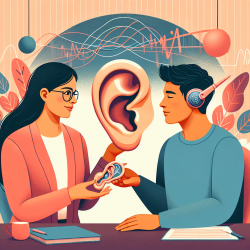The phenomenon of Binaural Intelligibility Level Differences (BILD) offers a fascinating insight into how the human auditory system processes speech in noisy environments. Understanding and applying the principles derived from BILD research can significantly enhance speech therapy practices, especially for hearing-impaired individuals. This blog post delves into the research conducted by Sanford E. Gerber in the study titled "Binaural Intelligibility Level Differences in Normal and Hearing-Impaired Individuals," exploring its implications for practitioners and encouraging further exploration in this field.
Gerber's study investigates the BILD phenomenon, focusing on how interaural phase differences can improve speech intelligibility against background noise. This research is particularly relevant for speech therapists and audiologists seeking to enhance auditory processing capabilities in individuals with hearing impairments.
Key Findings and Their Implications
The study's findings reveal that:
- Phase reversal of a speech signal amidst multitalker noise does not significantly improve speech intelligibility for hearing-impaired elderly individuals.
- Improvements in speech intelligibility are consistent across different Signal-to-Noise (SIN) ratios, regardless of whether the signal or noise is phase-shifted.
- There is high variability in BILDs among individuals, leading to statistically insignificant results across different groups.
These outcomes highlight the complex nature of auditory processing and the challenges in enhancing speech intelligibility through binaural interventions. However, they also open avenues for tailored auditory training and the development of hearing aids that can manipulate interaural phase differences more effectively.
Practical Applications for Practitioners
Speech therapists and audiologists can draw on the insights from this research in several ways:
- Customized Auditory Training: Develop training programs that focus on improving the ability of hearing-impaired individuals to process speech in noisy environments. This could involve exercises that simulate various SIN ratios and background noise conditions.
- Advanced Hearing Aid Design: Collaborate with hearing aid manufacturers to explore designs that incorporate binaural processing features. Such features could aim to enhance speech intelligibility by exploiting the principles of BILD.
- Further Research and Collaboration: Engage in interdisciplinary research to explore the potential of binaural processing in addressing the challenges faced by hearing-impaired individuals. This could involve studies on the impact of age, hearing sensitivity, and cognitive factors on BILD.
Moreover, practitioners should remain cognizant of the high variability in individual responses to binaural interventions. This underscores the importance of personalized approaches in the assessment and treatment of hearing impairments.
Encouraging Further Research
While Gerber's study provides valuable insights, it also highlights the need for further research in this area. Future studies could explore:
- The impact of different types of background noise on BILD.
- The role of cognitive factors, such as attention and memory, in processing binaural cues.
- The effectiveness of binaural processing interventions in younger populations and those with different types of hearing impairments.
Such research could lead to breakthroughs in our understanding of auditory processing and the development of innovative therapeutic interventions.
Conclusion
Gerber's research on Binaural Intelligibility Level Differences sheds light on the complexities of speech intelligibility in noisy environments, especially for hearing-impaired individuals. By drawing on these insights, practitioners can enhance their therapeutic approaches, contributing to improved auditory processing and quality of life for those with hearing impairments. The journey towards understanding and harnessing the potential of BILD is just beginning, and continued exploration in this field promises to unlock new possibilities for speech therapy and auditory rehabilitation.
To delve deeper into this fascinating study and explore its findings in detail, please follow this link: Binaural Intelligibility Level Differences in Normal and Hearing-Impaired Individuals.










